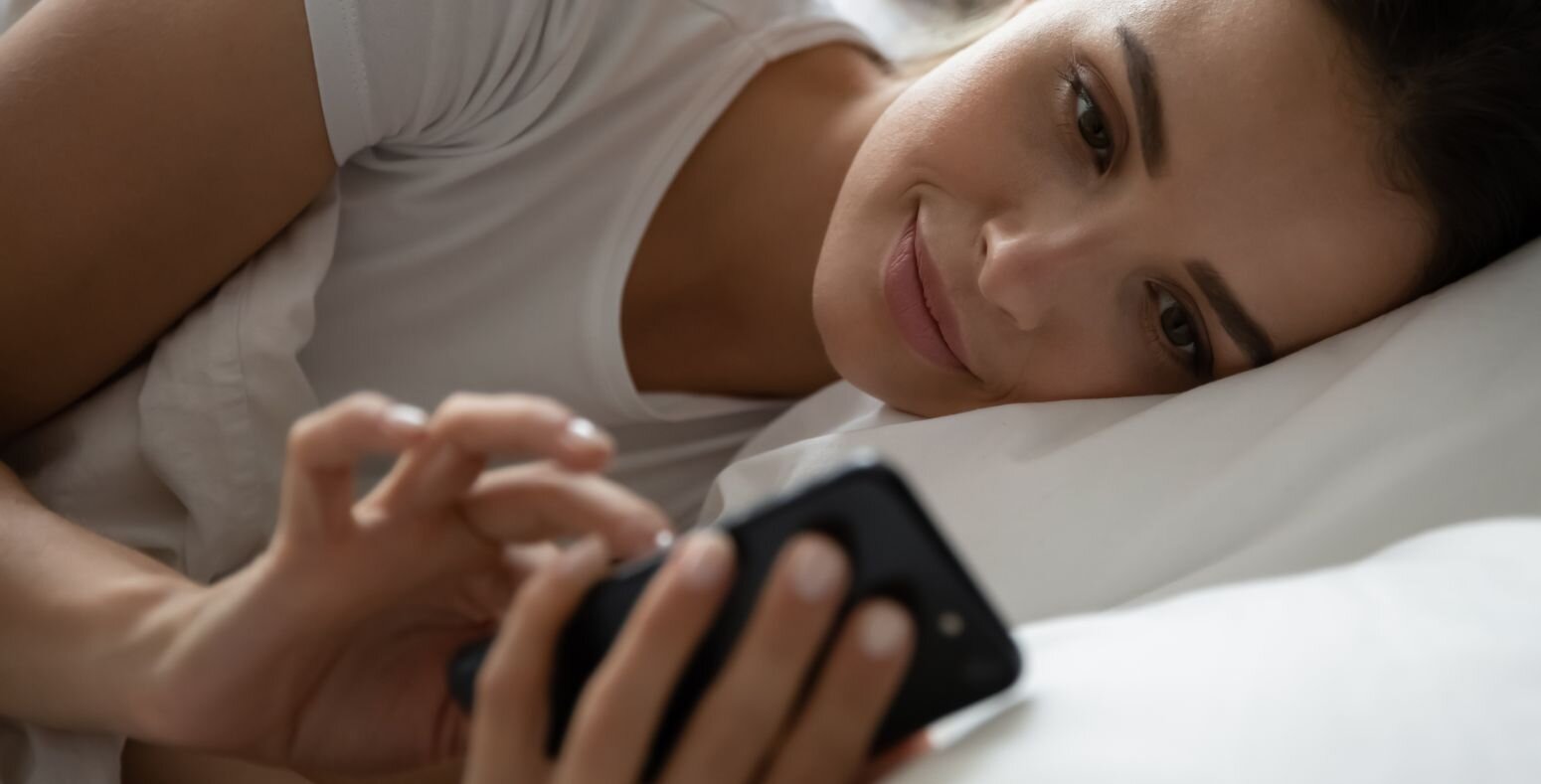
DOCTOR'S NOTE
Beyond UV: How Blue Light From Screens Contributes To Premature Aging.
As screen use increases, so does exposure to blue light. Here a dermatologist and doctor weigh in on how it can damage your skin—and your sleep cycle.
It’s well-known that UV exposure can have damaging effects on the skin, but blue light from devices is also a wavelength to watch. It’s a fact of modern life: Most people spend the majority of their waking hours glued to a screen. Whether it’s scrolling social media on your smartphone, working on your laptop, or binge-watching shows on a tablet, it’s estimated that people in the U.S. spend an average of seven hours a day in front of a blue-light-emitting device.
Most of us know that blue-light exposure can strain the eyes and disrupt sleep patterns, but that’s not all high-energy visible (HEV) light can do. “There have been increasing studies to suggest that sustained exposure to blue light, especially blue light from devices, can cause oxidative stress on the skin,” says Dr Roberta Del Campo, a board-certified dermatologist and Skin Laundry’s Chief Medical Officer. “Oxidative stress leads to signs of premature aging, an uneven skin tone and hyperpigmentation.”
Since there are no signs of device usage slowing down, it’s crucial that we learn what blue-light exposure can mean for the skin, and how to protect ourselves from it.
Read on to learn more about how blue light from devices can affect skin health and overall wellness and learn how to protect against it.
What Is Blue Light?
“Blue light is a short-wavelength part of the visible light spectrum,” Del Campo explains. “On the spectrum, it sits next to ultraviolet (UV) light, which poses the most significant threat to skin health. UV exposure is the number one cause of skin damage and premature aging.”
Read more about sun damage here.
While we get most of our blue-light exposure from the sun, it also comes from man-made devices such as fluorescent lighting, smartphones and laptops. The increasing amount of time that people spend in close proximity to these devices has dermatologists concerned about the long-term effects that blue light from devices will have on the skin.
Exposure to blue light can stimulate the generation of reactive oxygen species, or ROS, which causes oxidative stress that can lead to fine lines, wrinkles and more.
Blue Light and Signs of Aging
Research has shown that exposure to blue light can stimulate the generation of reactive oxygen species, or ROS, which can in turn cause oxidative stress. Oxidative stress leads to the breakdown of collagen and elastin, contributing to fine lines, wrinkles and other signs of aging.
Read more about aging skin here.
Furthermore, people often squint when they’re looking at their screens. Squinting causes the muscles around the eyes to contract, which can accelerate the formation of crow’s feet.
Blue Light and Hyperpigmentation
Hyperpigmentation is one of the biggest concerns related to blue-light exposure. When blue light from devices reaches the skin, it activates a light-sensitive protein within the melanocytes called Opsin 3. When Opsin 3 senses blue light, it can increase the activity of tyrosinase-related proteins, which produce melanin that can lead to hyperpigmentation.
Read more about hyperpigmentation here.
A recent study published in the Journal of Investigative Dermatology found that sunlight and blue-light devices can have similar results when it comes to causing increased pigmentation, swelling and redness in the skin.
While hyperpigmentation can be difficult to treat, our Signature Laser Facial targets pigmentation in the dermal layers of the skin without causing excessive inflammation.
Learn more about our Signature Laser Facial here.
While it’s hard to avoid screens altogether, there are things we can do to minimize the potential side effects of blue light on the skin.

Blue Light Skin Protection
While it’s hard to avoid screens altogether, there are things we can do to minimize the potential side effects of blue light on the skin. “I always recommend that my patients think about getting screen protectors for their computers,” Del Campo says. “That can help minimize pigmentation by reducing the amount of blue light that the device emits.” There are also topical solutions for blue-light protection.
Antioxidants can protect the skin from blue light. For example, Vitamin C serum can neutralize free radicals generated by blue-light exposure, and it can also inhibit the production of excess pigmentation.
Broad-spectrum SPF is a must for protection from UVA and UVB rays, and it can also protect the skin from blue light. Skin Laundry’s sunscreen contains zinc oxide, which can be particularly helpful in blue-light skin protection as it acts as a physical buffer between the skin and the light.
Shop Sun Defense Mineral SPF 30 Sunscreen
Blue Light and Holistic Skin Health
Sleep and skin health are intimately connected, and exposure to blue light before bedtime can hurt sleep cycles. “Light is the strongest factor that influences your circadian rhythm,” Dr Angela Holliday-Bell, a board-certified pediatrician and certified sleep specialist, said at Skin Laundry’s 2024 Wellness Retreat.
“Blue light in particular has the strongest alerting effect on your circadian rhythm,” Holliday-Bell explained. “When you're looking at your phone or a tablet a few inches from your face, you're telling your brain you want to be awake and alert. This can delay your natural melatonin release by hours and make it more difficult to fall asleep and to get into the deep stages of sleep” when skin repair occurs.
Read more about sleep and skin health here.
While it’s tempting to scroll the day away, let this info serve as one more reminder to limit your screen time when possible. Your skin will thank you for it.
Doctor's Note
Dimming your screen and using the night mode on devices can also help moderate your exposure to blue light.
Additional Reading
Your Shopping Bag
Your shopping bag is empty











